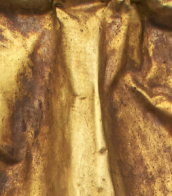anber

Jörg Schmeisser (Schmeißer) was a German artist who became particularly famous as a graphic artist and engraver. He studied at the Hamburg Academy of Fine Arts, 1962-67, and Kyoto, 1969-72. While studying in Hamburg he studied etching with Paul Wunderlich.
In the 1960s and 1970s he also participated in excavations in Israel and Greece as a draughtsman and travelled to many countries. From 1978 to 1997 he worked at the Canberra School of Art, part of the Australian National University. Jörg Schmeisser was head of the engraving department there.
In 1998 he travelled to Antarctica and stayed at the Australian research stations of Mawson and Davies. The etchings, drawings and paintings he created during this trip have been shown in numerous exhibitions in Australia, Japan, the USA and Germany.
After teaching and working in Jerusalem, Hangzhou, Angkor, Ladakh and Princeton, Jörg Schmeisser took up a professorship at Kyoto City Art University.


Jörg Schmeisser (Schmeißer) was a German artist who became particularly famous as a graphic artist and engraver. He studied at the Hamburg Academy of Fine Arts, 1962-67, and Kyoto, 1969-72. While studying in Hamburg he studied etching with Paul Wunderlich.
In the 1960s and 1970s he also participated in excavations in Israel and Greece as a draughtsman and travelled to many countries. From 1978 to 1997 he worked at the Canberra School of Art, part of the Australian National University. Jörg Schmeisser was head of the engraving department there.
In 1998 he travelled to Antarctica and stayed at the Australian research stations of Mawson and Davies. The etchings, drawings and paintings he created during this trip have been shown in numerous exhibitions in Australia, Japan, the USA and Germany.
After teaching and working in Jerusalem, Hangzhou, Angkor, Ladakh and Princeton, Jörg Schmeisser took up a professorship at Kyoto City Art University.





Richard Wilson was an influential Welsh landscape painter, who worked in Britain and Italy. With George Lambert he is recognised as a pioneer in British art of landscape for its own sake and was described in the Welsh Academy Encyclopedia of Wales as the "most distinguished painter Wales has ever produced and the first to appreciate the aesthetic possibilities of his country". In December 1768 Wilson became one of the founder-members of the Royal Academy. A catalogue raisonné of the artist's work compiled by Paul Spencer-Longhurst is published by the Paul Mellon Centre for Studies in British Art.

-VIL_WiKi.jpg)
Edward Alfred Cucuel was an American-born painter impressionist painter who lived and worked in Germany.



Nathaniel Niles is an American lawyer and politician, a member of the House of Representatives from Vermont.
Niles attended Harvard College and the College of New Jersey, eventually becoming a preacher but also active in politics. Niles sat in the lower house of the Vermont legislature for eight terms. From 1784 to 1787 he was a member of the state supreme court.
In addition to his sermons, he published numerous theological articles. When the American Revolution broke out in 1775, Niles enthusiastically supported the war against England. He even wrote his only work of poetry, an ode entitled "American Hero," to commemorate the Battle of Bunker Hill, which was set to music and became quite popular among New England soldiers and militia.


Harriet Beecher Stowe, full name Harriet Elisabeth Beecher Stowe, was an American writer and poet, an activist for the eradication of slavery in the country.
Beecher Stowe is the author of the world-famous novel Uncle Tom's Cabin. Published first in a newspaper and first published as a book in 1852, it aroused widespread anger in the country and galvanized the fight against slavery in the southern United States. This novel was later reprinted many times in all languages of the world and has been screened more than once.
In her youth, Beecher Stowe received an academic education, wrote poetry, notes and essays on social topics. In addition to "The Shack", she wrote several other novels and was engaged in teaching.


William Henry Edwards was an American amateur naturalist, entomologist, and businessman.
Edwards was a pioneer in the West Virginia coal industry, opening some of the earliest mines in the southern part of the state. He was also an accomplished naturalist and widely recognized as an authority on North American butterflies. As a businessman, he was involved in the coal industry, but the study of butterflies remained his passion.
During his lifetime he published some 250 scientific papers on scales, including a three-volume treatise, Butterflies of North America, which is highly regarded for its scholarship and the quality of its illustrations. Edwards paid great attention to the life stages of the insects in question, describing each stage in detail. The illustrations, on the other hand, were drawn by Mary Pirt, a talented Pennsylvania artist, and hand-colored by Lydia Brown.






Anthony van Dyck, a Flemish painter born in 1599 in Antwerp and passed away in 1641 in London, is celebrated as one of the foremost Baroque painters of the 17th century. His notable contributions to the art world include his exceptional portraits of European aristocracy, as well as his religious and mythological paintings. Van Dyck's early exposure to art was influenced significantly by his apprenticeship with Hendrik van Balen and later, by the profound impact of working alongside Peter Paul Rubens. His mastery was recognized early on, leading him to set up his own workshop by the age of 15.
Van Dyck's journey to Italy in 1621 marked a pivotal phase in his career, allowing him to immerse himself in studying the Italian masters and commencing his successful stint as a portraitist. His style evolved under the influence of Titian, evident from his vibrant use of color and refined modeling of form. Van Dyck's Italian period not only honed his artistic skills but also established his reputation as a painter of consequence.
Upon returning to Antwerp, van Dyck's portraits became highly sought after, leading to commissions from notable figures such as Archduchess Isabella and Queen Mother Maria de' Medici. His role as a court painter further solidified in England under the patronage of King Charles I, where he was knighted and appointed as the principal painter, profoundly shaping the aristocratic character of Charles I's reign through his portraits.
Van Dyck's legacy extends beyond his death, having influenced English portrait painting for over a century. His innovative techniques in watercolour and etching, along with his sophisticated portrayal of subjects, continue to be admired. His art not only showcases his technical prowess but also reflects the cultural and social nuances of his era, making his work a significant study for collectors and art historians alike.
For enthusiasts eager to explore the intersections of art, history, and culture through the lens of Anthony van Dyck's work, staying informed about new discoveries and auction events is essential. Signing up for updates can provide exclusive insights into the world of one of the most influential figures in Flemish art. This subscription ensures that collectors and experts are well-informed of any developments related to van Dyck's oeuvre, enhancing their understanding and appreciation of his contributions to the art world.

























































![Daniel Giraud Elliot | A monograph of the bucerotidae, or family of the hornbills. New York, [1876]-1882, fine plates by Keulemans](/assets/image/picture_3530945/0858a/rrsdrxzxxhbxpvqrwotocjaf3ttuqp2mkmdjuujntklnggbkietevtohrlsuahd1698994172jpg__fix_374_244.jpeg)
![Daniel Giraud Elliot | A monograph of the bucerotidae, or family of the hornbills. New York, [1876]-1882, fine plates by Keulemans](https://veryimportantlot.com/assets/image/picture_3530945/0858a/rrsdrxzxxhbxpvqrwotocjaf3ttuqp2mkmdjuujntklnggbkietevtohrlsuahd1698994172jpg__fix_374_244.jpeg)
















